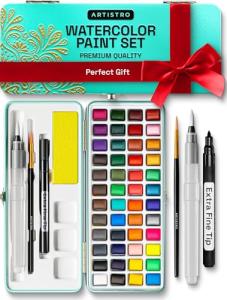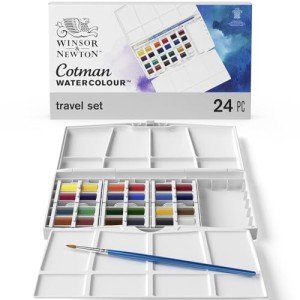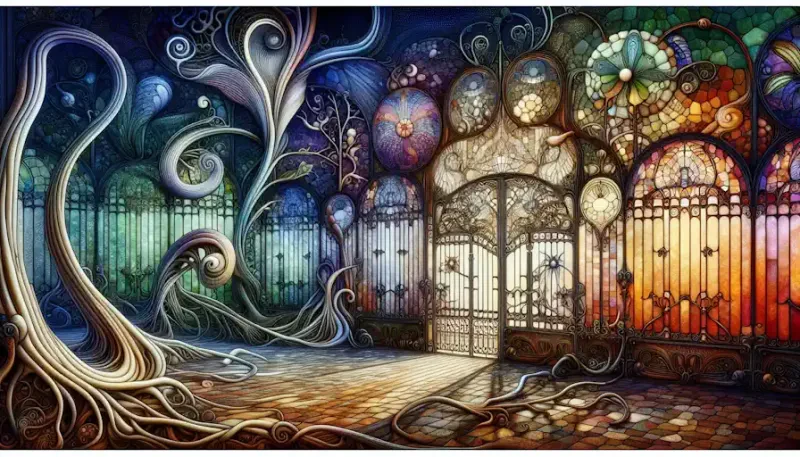Introdruction
Overview of Watercolor Painting
Watercolor painting is a timeless artistic practice that has been cherished for centuries for its unique characteristics and expressive potential. At its core, watercolor involves using pigments suspended in a water-based solution, typically applied onto paper. This medium is renowned for its transparency, allowing light to pass through the layers of paint, resulting in a luminous and ethereal quality to the artwork.
Watercolor's fluidity is one of its defining features, enabling artists to create smooth transitions between colors and delicate washes. This fluid nature also allows for spontaneous effects, as the paint can flow and blend unpredictably on the paper surface. Such qualities make watercolor particularly well-suited for capturing the subtle nuances of light and atmosphere, as well as conveying emotions and moods with remarkable simplicity.
The process of watercolor painting often involves building up layers of color gradually, with each layer contributing to the overall depth and richness of the composition. Artists employ various techniques to manipulate the paint, including wet-on-wet, wet-on-dry, and dry-brush techniques, each offering its own unique effects and possibilities.
Overview of Acrylic Painting
Acrylic painting emerged in the mid-20th century as a dynamic and versatile medium that quickly gained popularity among artists. Unlike traditional oil paints, which use linseed oil as a binder, acrylic paints consist of pigments suspended in an acrylic polymer emulsion. This results in a fast-drying medium that can be thinned with water and cleaned up easily with soap and water.
One of the key characteristics of acrylic paint is its versatility. Artists can choose from a range of consistencies, including fluid, soft body, and heavy body acrylics, each offering different handling properties and textures. This versatility allows for a wide range of artistic expression, from thin, translucent glazes to thick, impasto applications.
Acrylic paints are known for their vibrant colors and excellent lightfastness, making them ideal for artworks intended to last for years to come. Once dry, acrylic paint forms a durable, flexible film that adheres well to a variety of surfaces, including canvas, wood, paper, and fabric. This versatility makes acrylics suitable for a wide range of artistic styles and techniques, from detailed realism to bold, gestural abstraction.
In summary, both watercolor and acrylic painting offer unique advantages and creative possibilities for artists. Understanding the characteristics and properties of each medium is essential for choosing the right one to suit your artistic vision and preferences. Whether you prefer the delicate transparency of watercolor or the bold versatility of acrylics, both mediums offer endless opportunities for artistic exploration and expression.
Exploring the Characteristics of Watercolor: Transparency and Fluidity
Transparency: Harnessing the Lightness of Watercolor
Transparency is one of the most defining and captivating qualities of watercolor painting. It allows light to penetrate through layers of pigment, lending a luminous and ethereal quality to artworks. In watercolor, the paper serves as the "white" or lightest value, with subsequent layers of transparent pigment adding depth and complexity to the composition.
Achieving transparency in watercolor involves a delicate balance of pigment concentration and water saturation. By diluting pigments with varying amounts of water, artists can control the intensity of color and create subtle transitions between hues. This technique enables the depiction of nuanced effects such as the delicate veining of flower petals or the shimmering reflections on a body of water.
Moreover, transparency in watercolor allows for the layering of colors to build depth and dimension within the painting. Artists often apply multiple washes of transparent color, allowing each layer to dry before adding subsequent ones. This layering technique creates rich and complex color harmonies, as underlying hues subtly influence those applied above them.
Fluidity: Embracing the Flow of Watercolor Pigments
Fluidity is another essential characteristic of watercolor painting, stemming from its aqueous composition. Watercolor pigments dissolve readily in water, allowing them to flow smoothly and unpredictably across the paper surface. This inherent fluidity enables artists to create seamless washes, soft edges, and spontaneous blends, adding a sense of movement and dynamism to their compositions.
Embracing the fluidity of watercolor involves mastering the control of water and pigment on the painting surface. Artists manipulate the flow of paint by varying the wetness of the paper, the viscosity of the paint, and the angle at which the surface is held. By tilting or turning the paper, artists can encourage the paint to flow in specific directions, creating dynamic and organic shapes.
Furthermore, the fluid nature of watercolor allows for a range of expressive techniques, from controlled brushwork to gestural splatters and drips. Artists often exploit the unpredictability of watercolor to create spontaneous and serendipitous effects, embracing accidents and allowing them to inform the direction of their artwork.
In summary, transparency and fluidity are integral to the unique charm and expressive potential of watercolor painting. By harnessing these characteristics, artists can create artworks that are imbued with luminosity, depth, and a sense of vitality, capturing the beauty and essence of their subjects with remarkable delicacy and grace.
Unraveling the Versatility of Acrylics: Opacity and Texture
Opacity: Harnessing the Richness of Acrylic Paints
Acrylic paints offer artists a wide range of possibilities due to their opacity, allowing for vibrant and richly pigmented artworks. Unlike watercolor, which is inherently transparent, acrylic paints can be formulated to varying degrees of opacity, from translucent to completely opaque. This versatility allows artists to create bold and expressive compositions with strong color saturation.
The opacity of acrylic paints makes them ideal for covering underlying layers and creating opaque passages of color. Artists can apply acrylic paints thinly to achieve translucent glazes or layer them thickly to create impasto textures. Additionally, acrylics can be mixed with mediums to alter their opacity and extend their drying time, providing further control over the painting process.
Texture: Building Dimension and Depth with Acrylic Mediums
Texture is another key characteristic of acrylic painting, offering artists the opportunity to create tactile and visually engaging surfaces. Acrylic mediums, such as gels, pastes, and modeling pastes, can be added to acrylic paints to alter their consistency and create a variety of textures. These mediums can be applied with brushes, palette knives, or other tools to build up layers of texture on the painting surface.
Acrylic mediums allow artists to explore a wide range of texture effects, from smooth and glossy finishes to rough and textured surfaces. Artists can experiment with different application techniques, such as stippling, scraping, or layering, to achieve unique and expressive textures in their artworks. Furthermore, acrylic paints can be combined with various materials, such as sand, paper, or fabric, to create mixed-media artworks with rich textural depth.
In summary, the versatility of acrylic paints lies in their opacity and texture, offering artists the freedom to explore a wide range of techniques and effects. Whether working with translucent glazes or thick impasto layers, artists can harness the richness and depth of acrylic paints to create expressive and dynamic artworks that captivate the viewer's imagination.
Comparing Techniques: Layering and Blending in Watercolor
Layering: Building Depth through Transparent Layers
Layering is a fundamental technique in watercolor painting, allowing artists to build depth and complexity within their compositions. By applying successive layers of transparent washes, artists can gradually develop the tonal values and colors of their artwork. Each layer adds depth and dimension, as underlying colors subtly influence those applied above them.
The key to successful layering in watercolor lies in controlling the transparency and saturation of each wash. Artists often start with light washes to establish the underlying tones and gradually build up darker layers to add depth and contrast. By allowing each layer to dry before applying the next, artists can achieve crisp and clean transitions between colors, creating a sense of depth and luminosity in their artworks.
Blending: Achieving Seamless Transitions in Watercolor Washes
Blending is another essential technique in watercolor painting, allowing artists to achieve smooth and seamless transitions between colors. Unlike other painting mediums, watercolor lends itself naturally to blending due to its fluid nature and transparent properties. Artists can blend colors directly on the paper surface by wetting the area with clean water and then applying pigments with a brush.
There are various blending techniques that artists can employ in watercolor painting, including wet-on-wet, wet-on-dry, and dry-brush techniques. Wet-on-wet blending involves applying wet paint onto a wet paper surface, allowing colors to flow and merge organically. Wet-on-dry blending involves applying wet paint onto a dry paper surface, creating sharper edges and controlled blending. Dry-brush blending involves using a brush with minimal water to create textured and broken color effects.
By mastering the techniques of layering and blending, watercolor artists can create artworks that are characterized by depth, richness, and fluidity. These techniques allow artists to capture the subtle nuances of light and color, creating artworks that are both captivating and expressive.
Mastery of Techniques: Building Texture and Depth with Acrylics
Texture Techniques: Incorporating Gels, Pastes, and Impasto
Texture plays a crucial role in acrylic painting, offering artists the opportunity to create tactile and visually engaging surfaces. Acrylic mediums, such as gels, pastes, and modeling pastes, can be added to acrylic paints to alter their consistency and create a variety of textures. These mediums can be applied with brushes, palette knives, or other tools to build up layers of texture on the painting surface.
Gels are translucent mediums that can be mixed with acrylic paint to increase its body and viscosity, allowing for thicker application and impasto techniques. Pastes are opaque mediums that contain aggregates such as sand, glass beads, or fibers, creating rough and textured surfaces. Modeling pastes are dense mediums that can be molded and sculpted, adding three-dimensional elements to the artwork.
By experimenting with different texture mediums and application techniques, acrylic artists can create artworks that are rich in tactile depth and visual interest. Whether working with smooth and glossy finishes or rough and textured surfaces, artists can use texture to enhance the expressive qualities of their artworks and engage the viewer's senses.
Depth Techniques: Creating Illusion and Dimension with Acrylics
Creating depth is another essential aspect of acrylic painting, allowing artists to imbue their artworks with a sense of space and dimension. Acrylic paints can be layered and glazed to create depth, with lighter colors applied to the foreground and darker colors applied to the background. This creates the illusion of atmospheric perspective, with distant objects appearing lighter and less defined than closer objects.
Additionally, artists can use techniques such as scumbling, dry brushing, and sgraffito to create depth and texture within their artworks. Scumbling involves applying a thin layer of opaque paint over a dry surface, creating a soft and hazy effect. Dry brushing involves using a brush with minimal paint to create subtle highlights and shadows. Sgraffito involves scratching into wet paint to reveal underlying layers, creating intricate textures and patterns.
By mastering the techniques of texture and depth, acrylic artists can create artworks that are dynamic, layered, and visually captivating. These techniques allow artists to explore the expressive potential of acrylic paints, creating artworks that are rich in texture, depth, and complexity.
The Role of Control: Precision and Detail in Watercolor
Precision Techniques: Utilizing Fine Brushes and Masking Fluids
In watercolor painting, achieving precision and detail requires a combination of careful brushwork and strategic use of masking fluids. Fine brushes with pointed tips allow artists to create intricate lines, delicate shapes, and precise details in their artworks. By varying the pressure and angle of the brush, artists can control the thickness and intensity of the lines, achieving subtle variations in tone and texture.
Masking fluids are another valuable tool for preserving areas of white paper and creating crisp highlights in watercolor paintings. Applied with a brush or pen, masking fluids create a temporary barrier on the paper surface, preventing paint from adhering to the masked areas. Once the painting is complete and the paint has dried, the masking fluid can be removed to reveal the pristine white areas underneath, adding clarity and definition to the artwork.
Detail Work: Capturing Intricacy and Nuance in Watercolor Painting
Capturing intricate details and subtle nuances is a hallmark of watercolor painting, requiring patience, precision, and keen observational skills. Artists often work in layers, gradually building up the details and refining the composition with each subsequent wash. By carefully observing the subject and paying attention to subtle variations in color, value, and texture, artists can capture the essence of their subject with remarkable accuracy and sensitivity.
Detail work in watercolor painting often involves a combination of techniques, including dry-brushing, stippling, and fine-line work. Dry-brushing involves using a brush with minimal water to create texture and highlights, while stippling involves applying dots or small marks to create texture and shading. Fine-line work involves using a fine brush or pen to create intricate lines and patterns, adding depth and definition to the artwork.
By mastering precision techniques and embracing detail work, watercolor artists can create artworks that are both intricate and expressive. These techniques allow artists to capture the beauty and complexity of the natural world, creating artworks that resonate with depth, emotion, and authenticity.
Embracing Spontaneity: Expressive Techniques in Acrylic Painting
Wet-on-Wet Techniques: Exploiting the Fluidity of Acrylic Paint
Acrylic painting offers artists the opportunity to embrace spontaneity and expressiveness through various techniques, including wet-on-wet painting. Similar to watercolor, wet-on-wet acrylic painting involves applying wet paint onto a wet surface, allowing colors to blend and merge organically. This technique exploits the fluidity of acrylic paint, enabling artists to create soft transitions, atmospheric effects, and dynamic color interactions.
To execute wet-on-wet techniques in acrylic painting, artists typically work quickly and intuitively, applying paint in broad strokes or gestural marks. By manipulating the viscosity of the paint and the moisture content of the painting surface, artists can control the degree of blending and diffusion, creating a range of effects from subtle gradations to bold juxtapositions of color.
Palette Knife Techniques: Creating Bold Texture and Gestural Marks
Palette knife techniques are another expressive approach in acrylic painting, allowing artists to create bold texture and gestural marks with ease. Unlike traditional brushwork, palette knives have a flat, flexible blade that can be used to apply thick layers of paint, scrape away paint, or create intricate textures and patterns.
To use a palette knife effectively, artists often work with thick, impasto acrylic paints and apply them in thick, sculptural strokes. By varying the pressure, angle, and direction of the palette knife, artists can create a variety of texture effects, from smooth and glossy finishes to rough and textured surfaces. Palette knife techniques allow artists to explore the tactile qualities of acrylic paint, creating artworks that are dynamic, expressive, and visually engaging.
By embracing spontaneous and expressive techniques in acrylic painting, artists can create artworks that are vibrant, energetic, and full of life. Whether working with wet-on-wet blending or palette knife texture, these techniques allow artists to unleash their creativity and explore the endless possibilities of acrylic paint.
Factors to Consider: Cost, Cleanup, and Drying Time
Cost Analysis: Evaluating the Expense of Watercolor vs. Acrylic Supplies
When choosing between watercolor and acrylic painting, it's essential to consider the cost of supplies associated with each medium. Watercolor painting typically requires fewer materials, as it can be done with just a few tubes of paint, brushes, watercolor paper, and a palette. However, high-quality watercolor paints and paper can be expensive, especially for professional-grade supplies.
On the other hand, acrylic painting may initially seem more costly due to the need for a wider range of materials, including acrylic paints, brushes, canvases or boards, and various mediums. However, acrylic paints are generally more affordable than watercolors, and acrylic mediums can extend the life of paints and provide additional versatility. Ultimately, the cost of supplies will depend on the artist's preferences, budget, and the scale of their artistic projects.
Cleanup Considerations: Comparing the Ease of Cleaning Watercolor and Acrylic Tools
Cleanup is another factor to consider when deciding between watercolor and acrylic painting. Watercolor painting requires minimal cleanup, as water-based paints can be easily rinsed from brushes and palettes with water. Additionally, spills and splatters are relatively easy to clean from surfaces, as watercolor paints are non-toxic and water-soluble.
In contrast, acrylic painting may involve more cleanup due to the use of acrylic mediums, which can be more challenging to clean from brushes and palettes. Acrylic paints dry quickly and form a durable, water-resistant film when dry, making them more difficult to remove once they've dried on surfaces. However, with proper care and maintenance, acrylic painting tools can be cleaned effectively using soap and water or acrylic brush cleaners.
Drying Time: Understanding the Differences in Drying Rates Between Watercolor and Acrylic Paints
Drying time is a significant consideration for artists working with watercolor and acrylic paints. Watercolor paints dry quickly when applied to absorbent paper, allowing artists to layer and blend colors with ease. However, watercolor paints remain reactive when dry, meaning that additional layers can be reactivated with water, allowing for continuous manipulation and blending.
In contrast, acrylic paints dry quickly to a water-resistant finish, making them ideal for artists who prefer to work quickly or build up layers of paint without waiting for each layer to dry. Acrylic paints can be thinned with water to extend their drying time, allowing for wet-in-wet techniques similar to watercolor painting. However, once dry, acrylic paints become permanent and cannot be reactivated with water, making it essential for artists to work efficiently and plan their compositions in advance.
Overall, factors such as cost, cleanup, and drying time should be carefully considered when choosing between watercolor and acrylic painting. Each medium offers unique advantages and challenges, and the best choice will depend on the artist's preferences, artistic goals, and working methods.
Surface Considerations: Choosing the Right Substrate for Watercolor and Acrylic Painting
Watercolor Surfaces: Exploring the Characteristics of Watercolor Paper
Watercolor painting typically requires a specialized surface known as watercolor paper, which is designed to absorb and hold watercolor pigments effectively. Watercolor paper comes in various weights and textures, including hot-pressed, cold-pressed, and rough. Hot-pressed watercolor paper has a smooth surface and is ideal for detailed work and fine brushwork. Cold-pressed watercolor paper has a slightly textured surface, offering a balance between smoothness and absorbency. Rough watercolor paper has a pronounced texture, creating interesting effects when paint is applied.
When selecting watercolor paper, artists should consider factors such as weight, texture, and sizing. Heavier-weight papers (measured in pounds or grams per square meter) are more durable and can withstand multiple layers of paint and lifting techniques. Additionally, papers that are internally or externally sized are better able to resist buckling and warping when wet.
Acrylic Surfaces: Exploring Versatile Substrates for Acrylic Painting
Acrylic painting offers artists a wide range of surfaces to choose from, including canvas, wood panels, paper, and more. Canvas is one of the most popular surfaces for acrylic painting, providing a flexible and durable support for heavy-bodied acrylic paints. Stretched canvas and canvas panels are readily available in various sizes and shapes, making them convenient options for artists.
Wood panels are another popular substrate for acrylic painting, offering a rigid and stable surface for both thin and thick applications of paint. Wood panels can be primed with acrylic gesso or other acrylic mediums to create a smooth, absorbent surface that accepts paint well. Additionally, artists can experiment with unconventional surfaces such as paper, fabric, or found objects to create mixed-media artworks with acrylic paints.
When selecting a surface for acrylic painting, artists should consider factors such as absorbency, texture, and rigidity. Absorbent surfaces allow acrylic paints to adhere well and dry quickly, while textured surfaces can add visual interest and depth to the artwork. Ultimately, the choice of surface will depend on the artist's preferences, working methods, and desired aesthetic outcomes.
Conclusion: Finding Your Artistic Voice Through Watercolor and Acrylic Painting
Watercolor and acrylic painting are two distinct mediums, each offering unique characteristics, techniques, and possibilities for artistic expression. Whether you're drawn to the delicate transparency of watercolor or the bold versatility of acrylics, both mediums provide endless opportunities for creativity and exploration.
Watercolor painting captivates with its luminous transparency and fluidity, allowing artists to capture the subtle nuances of light, color, and texture with remarkable delicacy and grace. Through techniques such as layering, blending, and detail work, watercolor artists can create artworks that are imbued with depth, emotion, and authenticity.
On the other hand, acrylic painting offers a dynamic and versatile approach to artistic expression, with its bold colors, rich textures, and quick-drying properties. Acrylic artists can experiment with a wide range of techniques, from impasto and palette knife work to wet-on-wet blending and mixed-media collage. The ability to build layers, create textures, and work quickly makes acrylic painting well-suited for artists who enjoy spontaneity, experimentation, and bold expression.
Ultimately, the choice between watercolor and acrylic painting comes down to personal preference, artistic vision, and individual working methods. Whether you're drawn to the soft, ethereal beauty of watercolor or the vibrant, expressive energy of acrylics, both mediums offer endless possibilities for self-expression and artistic exploration.
By embracing the unique characteristics and techniques of watercolor and acrylic painting, artists can find their own artistic voice and create artworks that resonate with depth, emotion, and authenticity. Whether you're a seasoned professional or a beginner just starting out, the journey of artistic discovery awaits, inviting you to explore, experiment, and create with passion and purpose.







